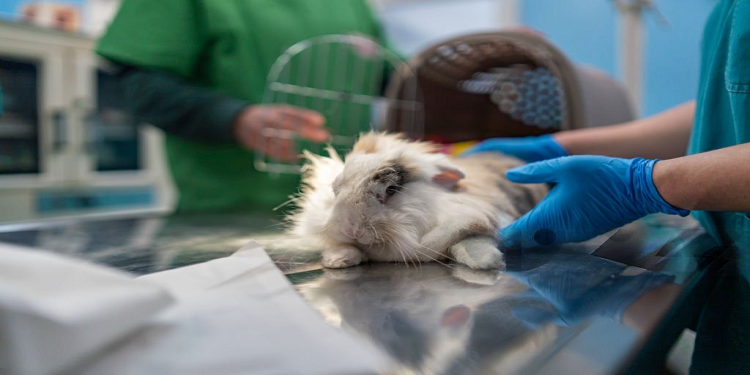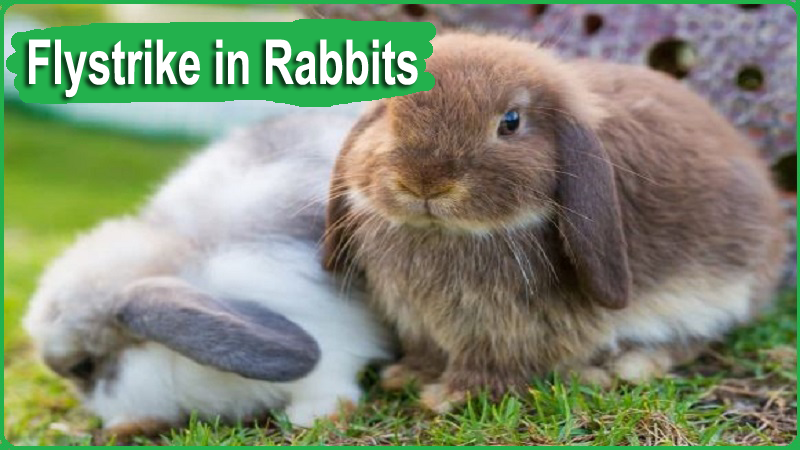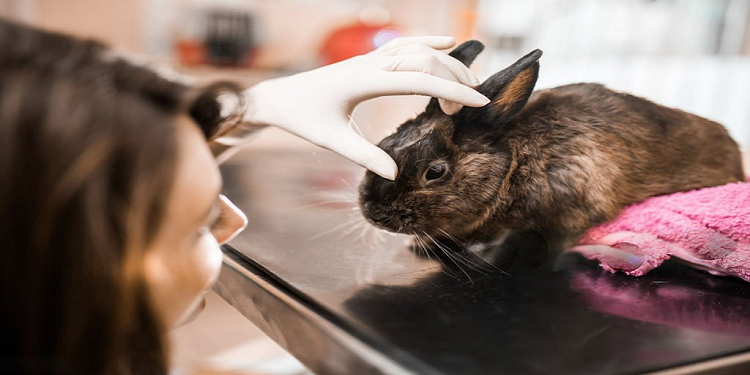Rabbits are soft fur and gentle disposition pets that comes joy and comfort to households. Although, they can also pose a harmful threat like as flystrike, most of rabbit owners are often overlooked it. From this article, we will try to highlight the hidden danger of flystrike in rabbits and their causes, symptoms, and proper treatment to ensure their well- health.
What is Flystrike in Rabbits?
Flystrike has another name as ‘Myiasis’ that is a severe and often fatal condition. This does affect your rabbits when flies, particularly blowflies, lay eggs on the bunny’s skin. Generally, this problem can effect such areas, where getting are moist, dirty, or opened wounds.
Once the eggs hatch completely, then larvae (maggots) gets burrow into the rabbit’s flesh and begins to feed on its tissue. Due to this, they can get severe pain, infection, and potentially death if not treated promptly. The primary reason of developing the flystrike is flies, when they get attract to such rabbits, which have soiled fur, wounds, or areas being contaminated with urine and feces.
This is especially common around the rabbit’s rear end and underbelly. It is challenging task to keep maintaining hygiene on those areas of bunny. Flies do to lay their eggs on the rabbit’s skin, usually in clusters. These eggs do easily hatch within a few hours. When eggs hatched, the maggots start to eat rabbit’s skin and tissue. Hence, it gets extensive damage as they burrow into the flesh.
Effect of Seasons on Flystrike
Rabbit’s flystrike is significantly affected by seasonal changes. The highest risk occurs during spring and summer. In these warmer months, blowflies are more active and reproduce rapidly. Along with, fly activities get increase, then spending more time with rabbits in outdoors, can increases their exposure to flies.
Fly eggs and larvae do development rapidly in warm weather that means a bunny can infest with maggots with ease. Besides of that, rabbits can get suffer from seasonal allergies or skin conditions that make wounds; and further flies attract on them.

In the fall, the risk of flystrike decreases as temperatures drop and fly populations get eliminate. But, still warm spells can lead a threat, so you have to need continued vigilance.
In winter, it has the lowest risk, because cold temperatures cause flies to become dormant or die off. Rabbits are typically kept indoors where the environment is controlled and clean.
Factors of Seasons on Flystrike
There are several interrelated factors of flystrike that make an environment conducive to fly infestation. Should be understood these causes is essential for prevention and management.
Poor Hygiene
One of the primary reasons of flystrike is bad hygiene in the rabbit’s living environment. Rabbit’s urine, feces, and soiled bedding create damp, dirty conditions that do attract flies. Particularly, blowflies are drawn to these unsanitary areas, where they lay their eggs.
Open Wounds and Skin Conditions
The higher risk of flystrike makes on such bunnies, who have open wound or skin issues. Flies are get more attractive to flesh and sores, so providing an ideal place for them to lay their eggs. Skin irritation or open wounds may increase the likelihood of infestation.
Also Read: How to Keep Rabbits Cool in The Summer? Expert Tips and Tricks
Obesity and Mobility Issues
Such rabbits, who are overweight or have mobility issues; they do more struggle to groom themselves properly. Due to this, it can build up of feces and urine around their rear end, then create a moist environment that gets attract flies. These rabbits have less capability to clean up any wounds or sores.
Warm and Humid Weather
Flystrike problem is more common in the warmer months when flies do more active. High temperatures and humidity increase the fly life cycle that allowing eggs to hatch and larvae to develop rapidly.
Inadequate Environmental Control
Rabbits do easily susceptible to flystrike, if their living areas haven’t proper fly control measures, such as flyscreens, traps, or repellents. Flies can easily get access such living areas that are not well-protected. Hence, it may increase the likelihood of egg-laying on the rabbits.
Early Sign Flystrike in Rabbits
With identifying the early signs of flystrike in rabbits, you can easily do treatment and preventing them. Here are the key early indicators to watch for:
Also Read: Snuffles in Rabbits and its Symptoms, Prevention, and Treatment
Restlessness and Discomfort: Rabbits may appear agitated, restless, or uncomfortable.
Excessive Grooming or Biting: The rabbit may excessively groom or bite at a specific area, usually the rear end.
Visible Maggots or Fly Eggs: Small white eggs or tiny maggots may be visible on the rabbit’s skin.
Wet Fur and Skin: Areas of the rabbit’s fur and skin may appear damp or wet, particularly around the rear end.
Unpleasant Odor: A foul smell may be noticeable due to the presence of maggots.
Reduced Appetite: The rabbit may show a decreased interest in food.
Lethargy: Affected rabbits may become unusually lethargic or inactive.
Irritation or Redness: The skin may show signs of irritation, redness, or inflammation.
Changes in Behavior: Any sudden changes in the rabbit’s usual behavior, such as hiding more than usual. It can be an early warning sign.
How Do You Prevent Fly Strike in Rabbits?
With following these preventive measures, you can significantly reduce the risk of flystrike to ensure well-health of your rabbits.
Maintain a Clean Living Environment
- Regularly clean and dry the rabbit’s living area to remove soiled bedding and feces.
- Minimize organic debris and stagnant water, which attract flies.
Implement Fly Control Measures
- Use flyscreens on windows and doors to prevent flies from entering the living space.
- Use fly repellents to reduce fly populations in the surrounding area.
Practice Good Hygiene
- Groom your rabbit regularly. Pay special attention to the rear end and underbelly.
- Check for signs of soiling, wounds, or skin conditions daily.
Monitor Diet and Digestive Health
- Provide a balanced diet high in fiber to promote healthy digestion to reduce the risk of diarrhea.
- Ensure access to fresh water at all times to prevent dehydration.
Flystrike Treatment for Rabbits at Home
Flystrike is a medical emergency and typically requires immediate veterinary care. However, if you cannot get to a vet right away, you can perform some initial steps at home. Here is a guide for emergency at-home treatment of flystrike in rabbits:
Also Read: Pregnancy in Rabbits: What Every Owner Should Know
Isolate the Rabbit: Move your rabbit to a clean and dry place away from other pets that helps to prevents further contamination.
Inspect and Clean the Area: Carefully examine the affected area. Use blunt scissors to trim the fur around the infested area. Be gentle to avoid causing additional pain.
Remove Maggots: Using tweezers, carefully remove visible maggots. Place the maggots in a container of rubbing alcohol to kill them. This process can be distressing for the rabbit, so handle them gently and calmly.
Clean the Wounds: Clean the affected area with a saline solution (saltwater) or an antiseptic solution. Avoid using hydrogen peroxide or alcohol directly on the wounds. Otherwise, these can cause additional pain and damage to the tissue.
Provide Supportive Care: Ensure the rabbit is kept warm and comfortable. Offer water and their favorite food to encourage eating. But, avoid forcing them to eat if they are not interested.
Pain Relief: If you have a pain reliever prescribed by your vet for your rabbit, give it according to the vet’s instructions. Never use human pain medications, as these can be toxic to rabbits.
Flystrike Diagnose and Treatment by Veterinarians
Flystrike (Myiasis) is a severe condition in rabbits that needs quickly veterinary attention. Veterinarians have experince to diagnose and treat this condition effectively.

Diagnosis of Flystrike
Physical Examination: Firstly, the veterinarian will conduct a thorough physical examination of the rabbit. This includes, do inspect the fur and skin, particularly around the rear end and any other moist or soiled areas. To identify the presence of maggots, eggs, and signs of tissue damage.
Assessment of Severity: The vet will do assessment the infestation and the severity of the tissue damage. This includes checking for signs of infection, necrosis (dead tissue), and the overall health of the rabbit.
Medical History: The veterinarian may take a medical history from the owner. In which, includes recent changes in behavior, diet, environment, and any previous health issues. On the behalf of this information, they can understand the underlying causes and risk factors.
Treatment of Flystrike in Rabbits
There are many steps, you can follow them one by one:
Immediate Veterinary Care
- Seek professional veterinary care immediately.
- Follow all instructions provided by the vet.
Initial Assessment
- Carefully examine the rabbit to identify affected areas.
- Determine the extent of the infestation.
Cleaning the Wound
- Gently clean the affected area with warm water and antiseptic solution.
- Remove any visible maggots using tweezers.
Shaving the Fur
- Shave the fur around the infested area to better access and treat the wound.
Antiparasitic Treatment
- Administer prescribed antiparasitic medication to kill remaining maggots.
- Apply a topical insecticide if recommended by the vet.
Wound Care
- Apply prescribed antibiotics to prevent infection.
- Use antiseptic creams or sprays as directed.
Pain Management
- Provide pain relief medication as prescribed by the veterinarian.
Supportive Care
- Ensure the rabbit is in a clean, dry environment.
- Provide fluids and nutritional support if the rabbit is weak or dehydrated.
FAQs (Frequently Asked Questions)
How Do Bunnies Get Flystrike?
Bunnies can get flystrike when flies lay eggs on soiled, damp, or wounded skin, often around the rear end. Dirty living conditions, poor hygiene, and underlying health issues can increase the risk of flystrike.
Can Rabbit Survive Flystrike?
Yes! A rabbit can survive flystrike if it gets immediate veterinary treatment. Quick remove the maggots, cleaning of wounds, and appropriate medication that are essential.
How to Get Rid of Flystrike in Rabbits?
To get rid of flystrike in rabbits, seek immediate veterinary care. The vet will remove maggots, clean and disinfect wounds, and administer antibiotics and pain relief. Maintain a clean, dry environment and regularly check your rabbit for signs of infestation to prevent recurrence.
Is Flystrike Fatal in Rabbits?
Yes, if left untreated, flystrike can be fatal. Due to this, it can pose to severe tissue damage, systemic infection, and shock.
Can Indoor Rabbits Get Flystrike?
Yes! Indoor rabbits can still get flystrike if flies are present inside the home. Good hygiene and regular checks are essential.
Final Notes
In final, we hope that you are completely educated about flystrike in rabbits that is a severe and prevalent condition, especially in the warm weather. As being a rabbit owner, you should be known about their risks, symptoms, and treatments associated with flystrike that contributes to protect your bunny’s health and well-being.
Also Read: Rabies in Rabbits and its Causes, Symptoms, Treatment, & Vaccine
If this article is valuable for you, then please share it along with your friends, family members, pet lovers or relatives over social media platforms like as Facebook, Instagram, Linked In, Twitter, and more.
Do you have any experience, tips, tricks, or query regarding on this? You can drop a comment!
Have a Nice Day!





